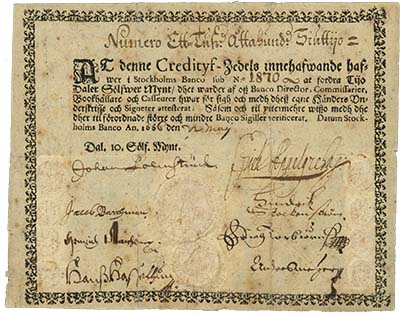
PREV ARTICLE
NEXT ARTICLE
FULL ISSUE
PREV FULL ISSUE
SPINK 2017 NEW YORK BANKNOTE AUCTION
A press release from Spink highlights lots from their upcoming New York banknote auction.
-Editor
Spink will be holding five numismatic auctions in January, and many of them will be taking place during the New York International Numismatic Convention at the Waldorf Astoria Hotel. The first of which will be the much-anticipated World Banknotes auction on January 13th. There will be several hundred lots of paper currency comprising specimen and issued banknotes from around the World. With just four hours to sell, we have squeezed in more than 350 lots of archival specimens, proofs and issued banknotes. The Swedish Palmstruch of 1666 
Fittingly, within this sale is an item Spink has been highly excited about all year- an example of Europe's first paper money, the Swedish Palmstruch of 1666, an important and historical note. Dated the very same year in which Spink can trace its own origins, lot 334 is issued by Stockholms Banco, and is a 10 daler silvermynt, third issue, with the serial number 1870. In 1656 Johan Palmstruch was granted a Royal Privilege to found a bank. Sweden was in considerable financial trouble largely due to the Thirty Years' War and the prevailing copper currency in circulation was cumbersome and impractical. Copper currency was deposited at the bank and paper issued. It is true that paper money was issued under the Ming Emperors but these were backed by the Emperor's Treasury unlike the 'Palmstruch' notes which were issued by a bank and can thus legitimately claim to be Europe's first example of paper money. Its boldly sweeping black text on cream parchment-like paper reads 'That the Bearer of this credit note has a claim upon Stockholms Banco numbered 1870 for 10 dalers silvermynt is attested by us, the Bank Director, Commissioners, Bookkeepers and Cashiers of the Bank each by his signature written with his own hand and by his seal; as well as authenticated for additional security by the large and the small Bank Seal intended for such purpose'. The signatures low left are: Johan Palmstruch, Jacob Barchman, Henrik Marheims and Hans Hasselhuhns, at the low right are the signatures of Erik Appelgrens, Henrik Stockenstroms, Eik Torbjornssons and Anders Meijers. Each signature has an embossed seal for authentication. A splendid example, very fine and above average for type. Extremely rare and historically important.
Bank of Italy Number 1 Set Giannini's business flourished and he started investing in the film industry financing Charlie Chaplin's 'The Kid' as well as several Disney films including Mickey Mouse and Snow White. By 1922 the Bank of Italy had 61 branches. Between 1927 and 1929 the Bank of Italy was authorised to issue National Currency bills, the set listed above being the number 1 set. In 1930 the Bank of Italy was renamed the Bank of America National Trust and Savings Association. In 1934 the Bank of America had 423 branches. Giannini died in 1950 having retired from the bank in 1945. He can justifiably be called one of the founders of modern banking in America and possibly of the biggest Bank in the world at the time of his retirement. He will always be remembered for not only his place in the history of banking but for his many philanthropic acts, the founder of the Bank and subsequently of the Bank of America, who could justifiably lay claim to the title of the founder of the American Banking system. A set of number 1 notes of this type is unheard of and coming from a family source is also of impeccable pedigree. The number 1 notes form lot 353,a set of notes comprising, $5, Benjamin Harrison at left, $10, William McKinley at left, $20, Hugh McCulloch at left, $50, John Sherman at left and $100, John Knox at left. All are dated San Francisco, February 26th 1927, third issue, and printed signatures of Speelman and White, manuscript signatures of R. B. Burnisted and James A. Bacigalupi. All are serial number 1, blue Charter number13044 in field. (Friedberg 609, 635, 661, 685, 707), originalgrade, generally extremely fine and an important Number 1 set.
To read the complete article, see:
The Numismatic Bibliomania Society is a non-profit organization promoting numismatic literature. See our web site at coinbooks.org. To submit items for publication in The E-Sylum, write to the Editor at this address: whomren@gmail.com To subscribe go to: https://my.binhost.com/lists/listinfo/esylum All Rights Reserved. NBS Home Page Contact the NBS webmaster 
|
